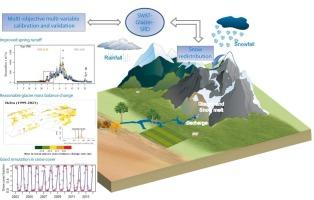考虑积雪再分布的天山西部冰川积累定量研究
IF 6.3
1区 地球科学
Q1 ENGINEERING, CIVIL
引用次数: 0
摘要
高山流域积雪再分布在水文模拟中起着重要作用。然而,积雪再分布很少被纳入半分布水文模型。这一遗漏给冰川物质平衡模拟带来了相当大的不确定性和潜在的偏差。本研究通过在SWAT-Glacier模型(SWAT-Glacier - SRD)中开发一个经验雪重分配模块(SRD)来解决这一挑战。在一定阈值下,积雪再分配量是坡度和积雪密度的函数。该模型应用于塔里木河流域最大的支流库马利克流域。为了约束水文成分,利用径流、冰川面积、物质平衡和雪平衡指数等多个观测数据对模型进行了校准。与SWAT-Glacier相比,SWAT-Glacier - srd能够更有效地模拟春季水流。校正期KGE为0.82,验证期KGE为0.57 ~ 0.91。该模型在再现冰川和积雪相关指数方面也取得了改进的性能。从1975年到2019年,冰川累积和消融的平均速率分别为0.573 m w.e.和0.850 m w.e.,导致冰川物质平衡为- 0.277 m w.e.。冰川累积从1975 - 1998年的0.460 m w.e.大幅增加到1999-2019年的0.697 m w.e.。冰川物质损失速率减缓,冰川物质平衡从- 0.359 m w.e(1975-1998)增加到- 0.187 m w.e(1999-2019)。本文章由计算机程序翻译,如有差异,请以英文原文为准。

Quantifying glacier accumulation in the western Tianshan Mountains considering snow redistribution
Snow redistribution in alpine catchments plays an important role in hydrological modeling. However, snow redistribution has rarely been incorporated into semi-distributed hydrological models. This omission has introduced considerable uncertainty and potential bias in glacier mass balance simulations. This study addressed this challenge by developing an empirical snow redistribution module (SRD) within the SWAT–Glacier model (SWAT–Glacier–SRD). The snow redistribution amount was a function of slope and snow density under a certain threshold. This model was applied to the Kumarik catchment, the largest tributary in the Tarim River Basin. To constrain the hydrological components, the model was calibrated using multiple observations, including runoff, glacier area, mass balance, and snow balance indices. Compared to SWAT–Glacier, SWAT–Glacier–SRD was able to more effectively simulate spring streamflow. Kling–Gupta Efficiency (KGE) was 0.82 in the calibration period and ranged from 0.57 to 0.91 in the validation period. The model also achieved improved performance in reproducing glacier- and snow-related indices. From 1975 to 2019, the mean rates of glacier accumulation and ablation were estimated at 0.573 m w.e. and 0.850 m w.e., respectively, resulting in a glacier mass balance of −0.277 m w.e. Glacier accumulation increased substantially from 0.460 m w.e. during 1975–1998 to 0.697 m w.e. during 1999–2019. The rate of glacier mass loss slowed, with glacier mass balance increasing from −0.359 m w.e. (1975–1998) to −0.187 m w.e. (1999–2019).
求助全文
通过发布文献求助,成功后即可免费获取论文全文。
去求助
来源期刊

Journal of Hydrology
地学-地球科学综合
CiteScore
11.00
自引率
12.50%
发文量
1309
审稿时长
7.5 months
期刊介绍:
The Journal of Hydrology publishes original research papers and comprehensive reviews in all the subfields of the hydrological sciences including water based management and policy issues that impact on economics and society. These comprise, but are not limited to the physical, chemical, biogeochemical, stochastic and systems aspects of surface and groundwater hydrology, hydrometeorology and hydrogeology. Relevant topics incorporating the insights and methodologies of disciplines such as climatology, water resource systems, hydraulics, agrohydrology, geomorphology, soil science, instrumentation and remote sensing, civil and environmental engineering are included. Social science perspectives on hydrological problems such as resource and ecological economics, environmental sociology, psychology and behavioural science, management and policy analysis are also invited. Multi-and interdisciplinary analyses of hydrological problems are within scope. The science published in the Journal of Hydrology is relevant to catchment scales rather than exclusively to a local scale or site.
 求助内容:
求助内容: 应助结果提醒方式:
应助结果提醒方式:


